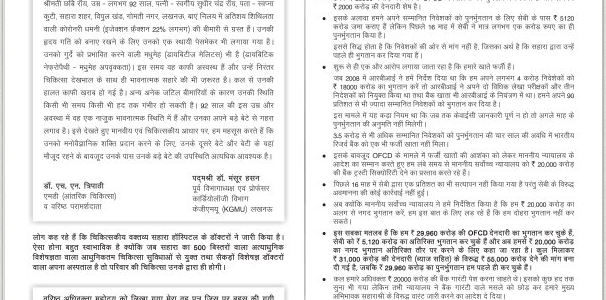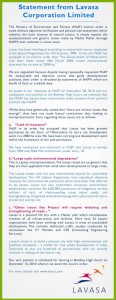Update – February 27, 2014: Nothing much has changed, I see. India’s Supreme Court issued a non-bailable warrant against Sahara Chief Subrata Roy yesterday for failing to appear in court and as many people joked on Twitter, there are full page ads in newspapers today. I did not see any ads in Bangalore, but there are ads at least in Maharashtra – I noticed them in Loksatta, Sakal and Sakaltimes. The question remains – who is Sahara speaking to? Going by the tone and language in the ads, it seems like they are speaking to the public. Next obvious question – why? What would they achieve? Who are they trying to sway, with this ad? Do they expect large groups of people to do dharna outside Supreme Court as a result of these ads? Whichever way you see it, this is a baffling PR strategy!
Ad in Sakal:
Ad in Sakaltimes (English):
Ad in Loksatta (couldn’t save the full-sized image from the epaper; the content seems to be the same the one in Sakal, but for the headline!)
****
Original post:
When you cannot convince somebody…or when you think that the other, influential party has a vested interest in bringing you down, you simply make a massive banner and hold it in the middle of the road.
What was that opening sentence about, you wonder? It is about Sahara’s advertisement in some of the leading newspapers in India today – in the front page, that too.
This is that advertisement (click on it for a larger view).
One of my favorite PR bloggers has already covered what I’m about to write here (In a modern crisis, a full page print ad is as relevant as yesterday’s news), but let me add some of my perspective to this too.
1. Usually (or, ‘earlier’), such ads used to be about setting facts right. They largely remained at a factual level without passing an opinion, given the paid nature of this communication. The Lavasa team did something similar twice, if my memory serves right, but those fact sharing advertisements were merely coated with mild opinion from their side.
See these two advertisements by Lavasa that appeared in leading publications late last year.
Despite the ‘we are anguished because‘ tone in the first advertisement by Lavasa (above), it still remains a fact sharing attempt, given how the rest of the advertisement goes.
But, this Sahara advertisement seems interesting since there is no fact anywhere in it and it is only loaded with opinions – a point of view by Sahara that ‘some sections’ of media are hounding them due to vested interests.
2. The language in Sahara’s advertisement is worth a closer look. It says that Sahara India Parivar is ‘astonished’ and ‘cannot believe’ that they are being pushed into this situation. Does having such a headline (Astonishing And Unbelievable) somehow means that they want us (the readers) to see their point of view and be astonished too? Wouldn’t that ideally depend on the credibility Sahara built (over the years, if at all) besides releasing such advertisements?
3. ‘We are astonished in the manner in which some leading newspapers…’ goes the opening line. So, it amounts to saying that the fact published by media – that the courts have issued a contempt of court notice to Sahara’s Chairman – is not wrong, but only the ‘manner’ in which it was reported that has ‘astonished’ this advertiser. And what is that manner?
Here’s a report from The Economic Times, one of the newspapers that carries this advertisement today. From what I see in those 3 paragraphs, I find standard reporting with appropriate use of words, including ‘allegedly’. I don’t see any extraordinary ‘manner’ in which a factual news is twisted in any way. Most other reports on this news in many other newspapers too sound largely the same – they quote the court in all cases and seem to be reporting a piece of news.
So, does this mean that Sahara did not want this news to be reported at all? Is publishing something about a rival news network wrong? One could argue vested interest in publishing such a story, but on what grounds can one claim ‘vested interest’ when such a thing has really happened and it enters the realm of news?
4. Coming to the crux of the advertisement, it says, in capital letters no less, that Sahara is ‘disturbed’ by the allegations seeking to connect Sahara Group with the 2G scam. If you read a sample report on this ‘connection’ (again, from The Economic Times), it says,
The Supreme Court today agreed to look into the issue of a journalist allegedly trying to influence the probe by the Enforcement Directorate in the 2G spectrum allocation scam.
A bench of justices G S Singhvi and A K Ganguly asked the petitioner, the Centre for Public Interest Litigation, to file all documents on this aspect after it was alleged that Upendra Rai, director (News) Sahara News Network, had tried to bribe one of the ED officers to get favour for corporate lobbyist Niira Radia.
Advocate Prashant Bhushan, appearing for the petitioner brought to the notice of the apex court that Rai had allegedly met an Assistant Director of ED and offered him Rs two crore as bribe for getting favour for Radia who has been under the scanner of various government agencies.
Again, Sahara’s angst could logically be directed against the ‘Centre for Public Interest Litigation’ which has filed this petition in the court. Instead, Sahara seems to have turned that angst against media publications that merely chose to report on a piece of news. That is indeed a strange tactic particularly when Sahara needs (through its advertisement) the reach of the same media to put forward its personal opinion on this issue.
5. The bold (as in black and bold!) statement in the 3rd paragraph goes, ‘We state that all such allegations are absolutely wrong and concocted with ulterior motives’. What is the purpose of this statement, I wonder? Is Sahara trying to win in the people’s court first – that is, change the perception of the people of this country about its honesty…before it could explain itself to the court? If winning people’s trust is the main purpose of this advertisement, is a paid spot (where an advertiser could get away with anything) the best way to go about it? Doesn’t it open more questions (from people) and put Sahara under even more intense spotlight?
6. As RepMan says in his post, enlisting credible third party observers to opine on this is a better bet, but since the issue is sub-judice, I doubt if Sahara could use that option right now – the timing is perhaps wrong. But again, even this advertisement that puts forward an opinion (Sahara’s alone) could be another contempt of court, I’d argue. If the matter is sub-judice, it’d perhaps mean that all concerned parties should not air their opinions till the court had an opportunity to listen to all arguments and offer its opinion (judgement). If that is the case, isn’t releasing an advertisement that purports to put forward Sahara’s perspective, that too alleging bias from the same media it chose to release the advertisement in, also be another contempt of court?
This is an interesting trend. Public relations was the tool used by such organizations to put forward an opinion, earlier. But, with allegations of media bias, organizations are opting to simply pay to get their perspective across to people, despite being fully aware that the credibility in paid advertisements is considerably lesser. That is the intriguing part – using a not-so-credible tool to offer notions of credibility!






